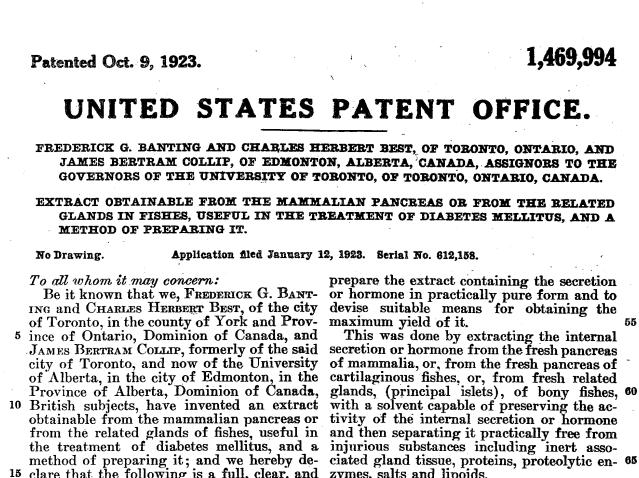Last year marked the 100th anniversary of a scientific breakthrough of enormous significance: the discovery of the role of insulin in diabetes. Prior to this invention, people suffering from diabetes (a metabolic disease characterised by elevated levels of glucose in the blood) had a very low life expectancy.
It was not until 1910 that the scientist Edward Albert Sharpey-Schafer hypothesised that diabetes was caused by a deficiency of chemicals prepared by the pancreas. He named this substance insulin, from the Latin “insula” (island), in reference to the pancreatic islets where it was supposed to be produced.
It was Canadian physicians Frederick Banting and Charles Best who succeeded in isolating insulin in 1921. They also demonstrated its effect on blood glucose levels by reversing diabetes in dogs whose pancreas had been removed. In collaboration with James Collip and J.J.R. MacLeod, they developed a procedure to purify insulin from bovine pancreas. By administering it, they were able to save a child’s life. Banting and MacLeod were awarded the Nobel Prize for Medicine in 1923. They considered it unfair that it had not also been awarded to Best and Collip and shared the prize money with them.
News of this breakthrough spread like wildfire and in order to meet the demand, the researchers signed an agreement with the pharmaceutical company Eli Lilly for its industrial production. The researchers decided to file a patent application on the process of purifying insulin obtained from mammalian or fish pancreas. The patent number is US1469994:

The three inventors assigned their patent rights to the University of Toronto for the symbolic amount of $3. The University decided not to enforce the patent. The purpose of filing a patent application was to describe the process in a sufficiently clear and complete manner so that it could be carried out by others (sufficiency of disclosure). The aim was to prevent imitators from obtaining lower quality insulin. This has been used in these pandemic years by critics of the patent system as an example of what could have been done with patents on SARS-CoV-2 vaccines to facilitate access to them.
In the historical archive of the Spanish Patent and Trademark Office (OEPM), the first Spanish patent where reference is made to insulin dates from 1928; P108091, entitled “a syringe for insulin injections” in the name of Manuel Martínez Moreno, resident in Barcelona. A few years after the first purification procedure was patented in the United States, it seems that the administration of insulin was already common in Spain, according to the description of this Spanish patent P108091, as it refers to the fact that insulin was supplied in units of measurement different from those normally used in the graduations of the syringes then available in Spain. The syringe protected by the patent had two graduations: “one for use with insulin solutions with a concentration of 40 international units in 1 cubic centimetre and another for use with insulin solutions with a concentration of 20 international units per cubic centimetre”.
The first Spanish patent referring to an insulin preparation process is ES0141402 A1, whose applicants were Danish nationals. It sought to solve one of the problems that the insulins on the market then presented , which was their lack of homogeneity:

Last year, coinciding with the 100th anniversary of the isolation of insulin, the WHO (World Health Organisation) published a report on access to insulin and its conclusion is that one in two people diagnosed with diabetes in the world do not have access to insulin or experience numerous difficulties in accessing it. There are several reasons for this:
- There is an increasing use of high-priced synthetic insulins.
- Three multinational companies control about 90% of the world insulin market, limiting competition.
- Research is focused on the needs of richer countries.
- Logistical and infrastructural difficulties in health systems.
In the United States, difficulties in accessing insulin are related to the high price of insulin. This article from the Mayo Clinic points to the patent policy known as “evergreening”, which aims to extend patent protection, as one of the culprits for this prohibitive price. New formulations are continually being developed and protected by patent, and it is these new formulations that are prescribed, thus preventing or hindering the marketing of generics or biosimilars.
The treatment of type I diabetes (which usually occurs in children and young adults and in which the pancreas does not produce insulin) involves the periodic injection of insulin, and this has led to numerous inventions related to these injections.
In 2016, TIME magazine selected as one of the best inventions of the year an invention by Medtronic, a device the size of an MP3 player that continuously measures blood sugar levels, preventing the patient from having to do so and injecting insulin when necessary. This technology is the subject of numerous patent documents such as US2016256629.

The search for new insulins has not ceased and the goals for the next few years are:
- An insulin that can be administered once a week.
- An insulin that can be administered orally.
- Insulins that react quickly to variations in blood glucose level, avoiding hypoglycaemic and hyperglycaemic situations.
Leopoldo Belda Soriano
Proofread by Ben Rodway
I came across your blog while doing research for my own. You have some interesting stuff on here!
LikeLiked by 1 person
Glad to know you like it. Yours is also interesting.
LikeLiked by 1 person